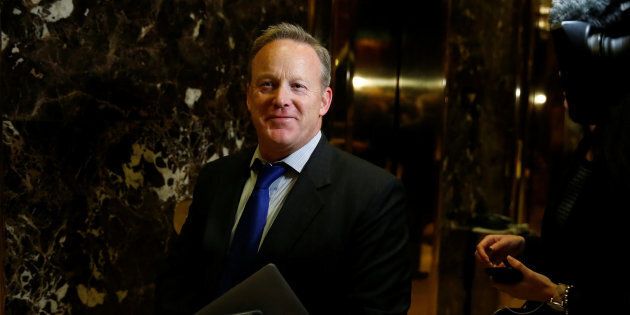

Sean Spicer, a top surrogate for Donald Trump’s presidential campaign who’s now a senior communications adviser for his transition, has been named White House press secretary.
Spicer, who had been Republican National Committee communications director since 2011 and the party’s chief strategist since 2015, was a forceful defender of Trump in the media, even as some Republicans kept their distance or opposed his candidacy. An August headline in The Washington Post captured his predicament: “What happens when you tie your career to Donald Trump? Ask Sean Spicer in a few months.”
The move paid off for Spicer, a figure well known to Washington journalists who’ll be covering the Trump White House.
Though Spicer has longstanding relationships with many reporters, he isn’t shy about aggressively challenging their reporting and analysis on television and social media ― and even in person. During a Politico event last week, Spicer said the publication, in many cases, covers Republicans in a “tweet-happy” style that’s “devoid of facts.”
Spicer was named Thursday along with other members of the senior communications team. Hope Hicks, who was Trump’s lone spokesperson for a long stretch of the 2016 election, will be director of strategic communications. Jason Miller will be director of communications, and Dan Scavino was named director social media. All four also hold the title of assistant to the president.
“Sean, Hope, Jason and Dan have been key members of my team during the campaign and transition,” Trump said in a statement. “I am excited they will be leading the team that will communicate my agenda that will Make America Great Again.”
Spicer also thanked the president-elect on Twitter.
White House Correspondents’ Association President Jeff Mason congratulated the newly appointed communications team on Thursday and said the organization looked “forward to working with all of them in the months ahead.”
There are sure to be many conversations, and possibly disputes, as the Trump administration settles in.
The Trump team is reassessing some established customs in how the White House engages the press, a continuation of Trump’s precedent-breaking behavior during the campaign.
The Trump campaign blacklisted several news outlets, and the Republican nominee repeatedly attacked the media and threatened legal actions against news organizations. As president-elect, Trump has broken with tradition by limiting “protective pool” access and not holding a news conference.
In searching for a press secretary, the Trump transition team considered some unconventional picks, including Laura Ingraham, a conservative radio host and Fox News contributor with a history of criticizing the news media, and Fox News host Kimberly Guilfoyle.
The Trump team also interviewed Daily Mail U.S. political editor David Martosko, who emphasized the need to reimagine the press operation and look beyond established players in the briefing room, according to sources familiar with the discussions. Martosko suggested renaming the position “White House news secretary” and the press office “White House Office of News and Information.”
Even without such a symbolic shift, key figures in the transition have indicated that change is coming. Reince Priebus, the incoming White House chief of staff and Spicer’s former boss at the RNC, said last week that the Trump team is re-examining customs like the daily press briefing and seating arrangement.
During an interview Thursday on Fox News, Spicer said Trump won’t kick out news outlets in response to negative coverage, a serious concern given that the campaign denied press credentials to nearly a dozen news outlets, including The Huffington Post. Still, Spicer said the incoming White House will “look at at everything” and it may not be necessary to hold daily briefings or continue the practice of televising them.
The next day, on stage at a Politico event, Spicer said there should be more ways for the public to communicate with the White House press office and suggested the media pecking order in the briefing room should be reassessed.
“For too long, I think that we’ve had this very stale operation, which is all the mainstream media folks get front row seats, and it’s a question of, here are the broadcast networks, here’s The Washington Post, The New York Times,” Spicer said.
“What about some of the conservative media having some of the prized seats in there?” he asked. “What about having some of the top bloggers being able to come in?
Spicer demurred when asked who he’d like to see in the front row, but suggested sought-after spots could rotate or be available on a first-come, first-served basis.
“There should be a conversation,” Spicer said. “It shouldn’t just be, ‘Hey, here’s the status quo, let’s keep going.’”
This article has been updated to include a comment from the White House Correspondents’ Association president.